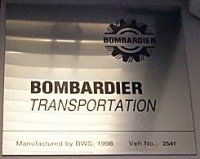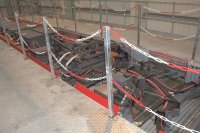|
||||||||||||
|
Home | ||||||||||||
  
|
||||||||
|
|
||||||||
|
The Trams |
||||||||
The choice to use proven technology appears to have paid off with virtually no problems being found with the trams themselves. Several changes have been made to enable the design to be approved for UK use and the centre articulated section houses seats where as the K-4000's have ticket machines. Some
elements of the continental design remain, noticeably the position of
the drivers door on the right hand side of the vehicle, as well as the
leading cabs side destination blind.
Trams are powered electrically at 750vdc by overhead wires and have a max speed of 80kph (50mph). Each tram can carry over 200 people with 70 seated - If you consider the road space needed for 200 people in private cars and then think about the road space used by a single tram, you'll get some idea about the effectiveness of these trams to move people. The
electrical equipment and traction equipment are supplied by Kiepe Electrik
from Düsseldorf, Germany. See this
page for the specifications of this equipment. Four 120kW 3-phase
asynchronous motors are fitted to the two, two axle power bogies at
the outer ends. The centre C-car rests on an unpowered 4 axle bogie.
Each powered wheel is fitted with sanding equipment discharged by the
traction system or manually by the driver. Due to the low floor design,
all the traction equipment is on the roof of the tram.
Croydon has 24 trams of which 21 are needed for the peak service between 0700 and 1900 Monday to Saturday. They are numbered 2530 through to 2553. This follows on from the highest numbered tram in the original London Transport tram numbering system. 2529 was scrapped long before the demise of the last trams in 1952. It is a nice touch that the numbers follow on - "Not so 'all new' as a continuation from where we left off." - Scott McIntosh, TfL |
||||||||
| Facts and Figures | ||||||||
A full specification can be found on this page of the Bombardier Website. |
||||||||
|
|
||||||||
| Drawing | ||||||||
|
CR-4000 Line Drawing |
||||||||
| Braking Systems | ||||||||
There are in fact 3 separate systems. The normal 'In Service' system relies on the overhead power supply (actually a battery 'floated' from the OHL supply) and is known as a Dynamic (regenerative or rheostatic) system. Basically when normal braking is applied, the driving motors in the front and rear bogies go into reverse and at the same time become electrical generators in their own right, either sending the electricity generated back into the overheads (regenerative) to help power other trams,or if the overheads are 'full-up' with electricity, it would be 'burnt-off' by what looks like an electric fire (See Photo) on the roof of each car (rheostatic), so in fact you could say these trams are 'Greener than Green'. The second braking system is a 'Disc' system, with disc's on all twelve wheels which are held off by hydraulics and spring applied 'failsafe', these are automatically applied when the tram slows to below 3 kph with the TBC in 'brake' mode and are the 'parking' brakes. The third braking system is the magnetic 'track brakes' system for emergencies, basically a 'shoe', each side of each bogie, each apply 6.66 tons of pressure onto the track and stops the tram very fast indeed, the shoes are assisted by applying sand onto the track to aid grip. This is sometimes known as the 'Hazard Brake' and all uses have to be reported to Controllers and logged. Sand is also applied automatically to the track should 'wheelspin' be detected at any time. |
||||||||
|
|
||||||||
| Designed by Trapdoor Internet Services |




